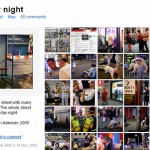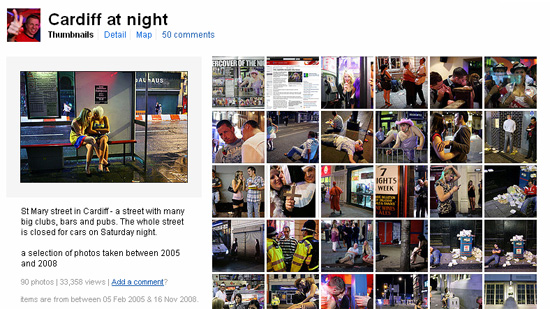
The story of a photographer whose photos went astray – and got re-published by one of the UK’s biggest newspapers without permission
There’s something really difficult about looking after your copyright on the internet. Every single word I’ve ever typed in this blog, for example, is duplicated at least a couple of times around the web. The problem is that words are easy to find. Pictures, on the other hand, are a different tumbler of guppies… As Maciej Dakowicz found out, when his photographs suddenly surfaced on the Telegraph’s online edition…
Photos going astray…
What had happened in this case is that someone found his rather awesome Flickr set called Cardiff at Night. Go look at it. Maciej is a brave, brave man for taking a Canon 5D out on the streets of Cardiff. It’s not the roughest city in the world, but, well, look at the photos; I did a photo project like this in Liverpool once, and people tried to mug me on several occasions. As for Maciej’s set, see Be Blessed, Night Calling, Cold Night and Police Car. In fact, look at the whole set, it’s a rather fine collection of night-time photography.
I’m digressing like a drunken prostitute in a snowstorm. Let me try to start that sentence again. What happened in this case is that someone found his rather awesome Flickr set, and posted it on an Hungarian site, probably with a title along the lines of ‘lol look at thz drnk english twats’, which would be largely incorrect, because the spelling hurts my eyes, and Cardiff is, in fact in Wales, so it’d be more fair to assume that the bulk of people in the photos are Welsh. I digress again.

Facsimile of Maciej’s Cardiff at Night Flickr set. (screenshot used under Fair Dealing)
After suffering the injustice of having his photos nicked once, someone at the Telegraph came across the photos, hashed them into a photo gallery, and published them. A lot of people – myself included - were impressed by the photo gallery, and ended up linking to it via blogs, Twitter, etc.
I shan’t speculate as to what sort of procedures the Telegraph have for checking copyright and reimbursing the photographers involved, but it’s pretty safe to say that whoever they got permission from didn’t have authority to give such permission. Someone subsequently recognised some of Maciej’s photos, and notified him. Understandably, he was pretty damn pissed off, grabbed a screen-shot, and e-mailed the Telegraph.
The Telegraph apologised and took the gallery down, offered their ‘usual fee they pay for online galleries’, says Maciej, which comes to £125. Nice of them, and I guess they’re making some sort of effort to solve the situation. My personal opinion is that offering up £125 for having stolen a gallery of photos is an insult, and that Maciej should get in touch with a solicitor to get suitable compensation, but that’s not the point of this article.
The point is, however, that this could have happened to just about anybody – .
So, what do you do when this happens to you?
First off, calm down.
No, really. Calm down. Flying off the handle is not going to do anyone any good – lot of people (yours truly very much included) get very indignant and angry about things like this, but naming and shaming (or ranting and raving, for that matter) is generally not the right thing to do – there are systems in place for dealing with copyright infringement, so use them…
If the people using your photos are a professional outfit (like a company, as opposed to, say, some random blog), your steps should be as follows: First off, immediately send a NTD – Notice and Take Down. This is a legal request in which you’re demanding the website in question removes your images immediately. In effect, they’ll have to remove them as quickly as possible, which normally means within 24 hours. For a publication (websites, newspapers etc), send the request to the photo editor – if the photo editor’s contact details aren’t on the website, give them a bell and ask for their details. CC the editor of the publication.
Now, hopefully, they’ve taken down your copyrighted material (if they haven’t, contact a solicitor, because they are now knowingly infringing on your copyright, which raises the stakes all around), and it’s up to you what you want to do. Personally, I’ve on occasion guilt-tripped the photo editor in buying other photography work from me in the future (with the idea that if my work is good enough to steal, it must be good enough to pay for), and in effect, I still supply photographs to one publication which stole my images by accident.
Alternatively, you can send them a bill (see how much shoudl I charge for a photo for an indication of how big that bill shoudl be) for unauthorised used. If they don’t pay, then file a small claims court judgement (this normally costs £25). What normally happens when you do that is that they’ll get in touch with you and settle well before it ends up in court. If you billed them £1,000 for a set of photos, and they offer you £600, I’d go for it, it’s more money than nothing, and it saves you the hassle of going through the legal system.
What if you can’t get in touch with them?
Some times, it’s nearly impossible to find out who is actually responsible for the copyright infringement – if someone posts your photos as their own on Flickr, you contact Flickr and they’ll deal with it for you. If it’s a hosted blog (like wordpress.com or blogger), you can report them to the host, and they’ll deal with it. If, however, it turns out that it’s someone running on a foreign domain, without any contact details (or, say, whenever you call the phone number on the domain registrar you get through to someone who only speaks Chinese – which happened to me once), you might find yourself in a spot of bother. This thread from 2004, for example, outlines what happened when someone nicked around 100 photos and placed them on a Russian site.
Lots more advice is available from the UK Copyright Service (like their Copyright Infringement Fact Sheet or the very useful 10 copyright myths). The Publishers Association Infringing Websites helps with some terminology which may come in useful.
Finally, it’s actually possible to go after the ISPs of the people hosting your content – which only helps if you can actually contact them, of course. If any part of the hosting business is based in the UK or USA, you have a case for going to them directly – they can then shut down the entire site if necessary – but only if they are co-operative, of course.
Finally, you can ensure that the enfringing site gets de-listed from Google by filing a Google Digital Millennium Copyright Act Infringement Notification, which takes a while, but might at least mean that the site hosting your copyrighted content gets less traffic than they normally would.
Further reading
I’ve done a lot of writing on this general topic recently – check, for example, Photo Licencing and the Law, Be careful what you sign, Can I use the photos I’ve taken? and how much should I charge for a photo?.
Finally, please note that I’m not a solicitor, and nothing posted in this blog may be construed as legal advice. Contact a solicitor for advice.
Do you enjoy a smattering of random photography links? Well, squire, I welcome thee to join me on Twitter - Follow @Photocritic
© Kamps Consulting Ltd. This article is licenced for use on Pixiq only. Please do not reproduce wholly or in part without a license. More info.





